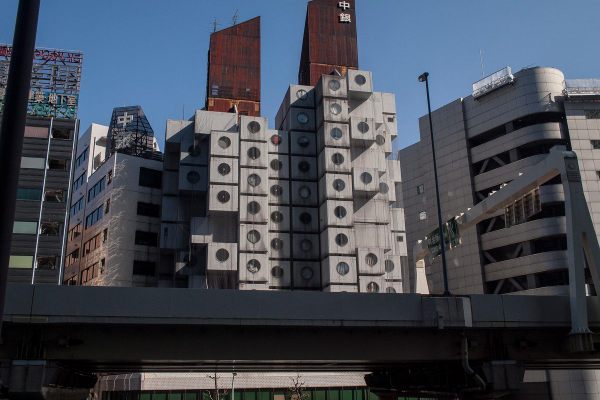Why Is Anime Obsessed With Power Lines?
Exploring the reasons behind the genre’s lavishly detailed electrical infrastructure.

Tumblr can be a wild and … fascinating place. If you can think of it, there is a probably a Tumblr blog dedicated to it. From Law & Order & Food to the classic Awkward Stock Photos to a Tumblr dedicated to other weird Tumblrs, there is something for everyone. But every so often, amid all the hyper-specific strangeness and absurdity, something emerges that shines a light on some previously unexplored facet of the world. We know what you’re thinking: Why are there so many shots of power lines in Japanese anime cartoons?
The Tumblr Power Lines in Anime is dedicated to appreciating the truly lovely and surprisingly ubiquitous depictions of mundane power lines that appear in a large number of Japanese animation series. The blog is run by Tumblr user whitequark, who first started to notice the trend while watching a romantic comedy anime. “I first noticed that power lines were ‘A Thing’ while watching Monthly Girls Nozaki-kun and looking at the background behind the reflection in the glass,” says whitequark, who prefers to use their online handle. “That made me think it over. Why, indeed, are there so many power lines? Why are these industrial constructs with lots of time-consuming detail drawn so consistently true to their nature?”


Anime series can cover any number of genres, including sports, high fantasy, office life, and, of course, science fiction, but no matter what it’s about, it seems that if the story is set on modern-day Earth, it will contain some amazingly detailed images of power lines, telephone poles, and other wired infrastructure. While a number of anime series (and cartoons in general), opt for a style of hyper-detailed backgrounds before which relatively simpler characters can interact, power lines stand out for the detail and complexity required to illustrate them. Speaking about one such power line shot, whitquark says, “It serves no purpose to the story. It is not repeated, emphasized, seems to have no useful purpose. Yet it is there! Someone cared about it, cared about it so much to go outside, take a photo, lovingly trace and color it to utter perfection.” They might be mundane, but their consistent presence could point to a deeper significance.
“It puts the power infrastructure first and foremost as narrative and visual elements of the anime,” says Marc Steinberg, a scholar of film studies at Concordia University in Montreal and author of Anime’s Media Mix. For years, he has been studying and teaching anime, and he has also noticed the prevalence of power lines. He traces the origin of the trend to one of the most popular anime series in recent memory. “I think it’s basically a post–Neon Genesis Evangelion phenomenon,” he says. “One of the peculiarities [of the series], besides the crazy storyline, is that it really focused on objects in everyday life in a way that anime before that had not, as much. This includes shots of telephone booths, shots of doorways, train crossings. Things that were associated with everyday life in Japan at that moment in time.” In that anime specifically, Steinberg says, power lines are specifically highlighted as a visual connection to the theme of power that runs through the series—most fantastically and prominently seen in the colossal power cords connected to the titular giant robots.
The trend didn’t stop with the series, but instead became a kind of signifier. “[Evangelion] had all these shots of power lines, and it became this signature for the more experimental, slightly more adult-oriented anime that became popular in the late 1990s, early 2000s,” says Steinberg. He also mentions another influential anime that may have helped cement anime power lines as a recurring trope, Serial Experiment Lain, released in 1998. The series, set in suburban Japan, focused heavily on themes of communication and electricity, and unsurprisingly had a number of illustrated power lines and telephone poles. whitequark says that they consider it “*the* power lines anime” (although their favorite anime power lines belong to a series called Monogatari).
Maybe the most obvious explanation for the trend of power line shots is that many anime stories take place in and around some version of Tokyo, which contains a great number of power lines and electrical pylons IRL. “You’re kind of covered in power lines. A lot of the power grid is above ground. In places where the power grid is mostly underground, it’s not as evident and visible an aspect of everyday city life. In part because of the trains that run on electricity,” says Steinberg. Power lines act as a signal of the mundane and the normal in the modern Japanese landscape. They aren’t the only image that appears regularly in anime to signal everyday life, they stand out as both one of the most common and the most visually complex. “Train crossings are one of the other big ones,” says Steinberg.
Over the last two decades, the power line trope can now be found in all kinds of anime, including smash hits such as One Punch Man. The presence of detailed background infrastructure in a cartoon might seem like a small thing, but once you notice them, these seemingly innocuous images take on a whole new significance. whitequark certainly won’t see anime the same way again. “This, to me, seems like a reflection of anime’s soul in general: Spend all of yourself on the things almost no one will notice, and spend yourself thrice on things that truly are important.”









Follow us on Twitter to get the latest on the world's hidden wonders.
Like us on Facebook to get the latest on the world's hidden wonders.
Follow us on Twitter Like us on Facebook